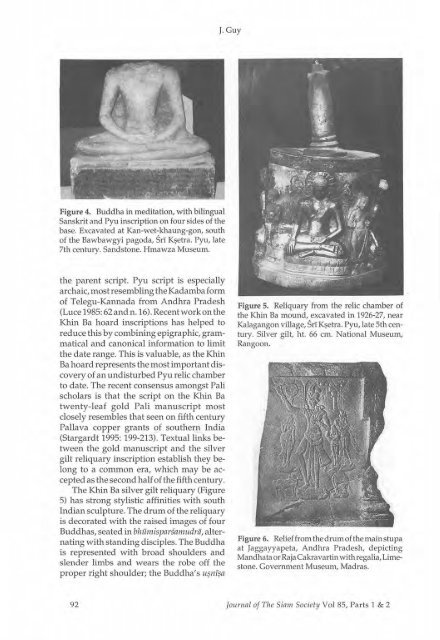The Journal of the Siam Society Vol. LXXXV, Part 1-2, 1997 - Khamkoo
The Journal of the Siam Society Vol. LXXXV, Part 1-2, 1997 - Khamkoo
The Journal of the Siam Society Vol. LXXXV, Part 1-2, 1997 - Khamkoo
Create successful ePaper yourself
Turn your PDF publications into a flip-book with our unique Google optimized e-Paper software.
J. Guy<br />
Figure 4. Buddha in meditation, with bilingual<br />
Sanskrit and Pyu inscription on four sides <strong>of</strong> <strong>the</strong><br />
base. Excavated at Kan-wet-khaung-gon, south<br />
<strong>of</strong> <strong>the</strong> Bawbawgyi pagoda, Sri K:;;etra. Pyu, late<br />
7th century. Sandstone. Hmawza Museum.<br />
<strong>the</strong> parent script. Pyu script is especially<br />
archaic, most resembling <strong>the</strong> Kadamba form<br />
<strong>of</strong> Telegu-Kannada from Andhra Pradesh<br />
(Luce 1985: 62andn.16). Recentworkon <strong>the</strong><br />
Khin Ba hoard inscriptions has helped to<br />
reduce this by combining epigraphic, grammatical<br />
and canonical information to limit<br />
<strong>the</strong> date range. This is valuable, as <strong>the</strong> Khin<br />
Ba hoard represents <strong>the</strong> most important discovery<br />
<strong>of</strong> an undisturbed Pyu relic chamber<br />
to date. <strong>The</strong> recent consensus amongst Pali<br />
scholars is that <strong>the</strong> script on <strong>the</strong> Khin Ba<br />
twenty-leaf gold Pali manuscript most<br />
closely resembles that seen on fifth century<br />
Pallava copper grants <strong>of</strong> sou<strong>the</strong>rn India<br />
(Stargardt 1995: 199-213). Textual links between<br />
<strong>the</strong> gold manuscript and <strong>the</strong> silver<br />
gilt reliquary inscription establish <strong>the</strong>y belong<br />
to a common era, which may be accepted<br />
as <strong>the</strong> second half <strong>of</strong> <strong>the</strong> fifth century.<br />
<strong>The</strong> Khin Ba silver gilt reliquary (Figure<br />
5) has strong stylistic affinities with south<br />
Indian sculpture. <strong>The</strong> drum <strong>of</strong> <strong>the</strong> reliquary<br />
is decorated with <strong>the</strong> raised images <strong>of</strong> four<br />
Buddhas, seated in bhumisparsamudra, alternating<br />
with standing disciples. <strong>The</strong> Buddha<br />
is represented with broad shoulders and<br />
slender limbs and wears <strong>the</strong> robe <strong>of</strong>f <strong>the</strong><br />
proper right shoulder; <strong>the</strong> Buddha's UEjnfE;a<br />
Figure 5. Reliquary from <strong>the</strong> relic chamber <strong>of</strong><br />
<strong>the</strong> Khin Ba mound, excavated in 1926-27, near<br />
Kalagangon village, Sri K:;;etra. Pyu, Ia te 5th century.<br />
Silver gilt, ht. 66 em. National Museum,<br />
Rangoon.<br />
Figure 6. Relieffrom <strong>the</strong> drum <strong>of</strong><strong>the</strong> main stupa<br />
at Jaggayyapeta, Andhra Pradesh, depicting<br />
Mandha ta or Raja Cakravartin with regalia, Limestone.<br />
Government Museum, Madras.<br />
92<br />
<strong>Journal</strong> <strong>of</strong> <strong>The</strong> <strong>Siam</strong> <strong>Society</strong> <strong>Vol</strong> 85, <strong>Part</strong>s 1 & 2

















